Video Lecture
Theory For Making Notes
Lorem ipsum dolor sit amet, consectetur adipiscing elit. Ut elit tellus, luctus nec ullamcorper mattis, pulvinar dapibus leo.
Practice Questions (Level-1)
Q.1
A copper rod of length l is rotated about one end perpendicular to the uniform magnetic field B with constant angular velocity w. The induced emf between two ends is –
(a) \frac{3}{2}Bwl2
(b) Bwl2
(c) 2Bwl2
(d) \frac{1}{2}Bwl2
Ans : (d)
Q.2
The wire AB slides with velocity v and remains in contact with fixed rails. If the wire AB is replaced by a semicircular arc, the magnitude of induced current will
(a) increase
(b) remain the same
(c) decrease
(d) depends on the orientation of arc

Ans. (b)
Q.3
A rod of length l rotates with a uniform angular velocity w about its perpendicular bisector. A uniform magnetic field B exists parallel to the axis of the rotation. The potential difference between the two ends of the rod is
(a) zero
(b) \frac{1}{2}Bl{{\omega }^{2}}
(c) Bl{{\omega }^{2}}
(d) 2Bl{{\omega }^{2}}
Ans : (a)
Q.4
A rod AB moves with a uniform velocity v An a uniform magnetic field as shown in figure.
(a) The rod becomes electrically charged.
(b) The end A becomes positively charged
(c) The end B becomes positively charged.
(d) The rod becomes hot because of Joule heating. A
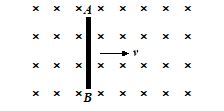
Ans. (b)
Q.5
A metal rod of length \vec{l} is moved with a constant velocity \vec{v} in a magnetic field \vec{B}. A potential difference appears across the two ends when
(a) \vec{v}||\vec{l}
(b) \vec{v}||\vec{B}
(c) \vec{l}||\vec{B}
(d) none of these
Ans: (d)
Practice Questions (Level-2)
Q.1
A conducting square loop of side L and resistance R moves in its plane with a uniform velocity v perpendicular to one of its sides. A magnetic induction B, constant in time and space, pointing perpendicular and into the plane of the loop exists everywhere. The current induced in the loop is
(a) BLv/R clockwise
(b) 2BLv/R anticlockwise
(c) BLv/R anticlockwise
(d) zero
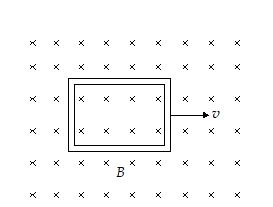
Ans. (c)
Q.2
A rod is rotating with a constant angular velocity w about point O (its center) in a magnetic field B as shown.

Which of the following figure correctly shows the distribution of charge inside the rod
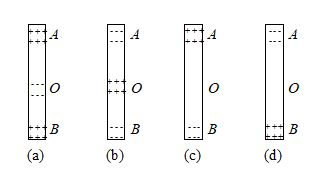
Ans. (a)
Q.3
A conducting straight wire PQ of length l is fixed along a diameter of a non-conducting ring as shown in the figure. The ring is given a pure rolling motion on a horizontal surface such that its center of mass has a velocity v. There exists a uniform horizontal magnetic field B in horizontal direction perpendicular to the plane of ring. The magnitude of induced emf in the wire PQ at the position shown in the figure will be
(a) Bvl (b) 2Bvl (c) 3Bvl/2 (d) zero
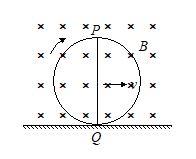
Ans. (a)
Q.4
A wire is bent in form of a V shape and placed in a horizontal plane. There exist a uniform magnetic field B perpendicular to the plane of the wire. A uniform conducting rod starts sliding over the V shaped wire with a constant speed v as shown in the figure. If the wire has no resistance, the current in the rod will
(a) increase with time
(b) decrease with time
(c) remain constant
(d) always be zero

Ans. (c)
Q.5
A conducting rod of length 2l is rotating with constant angular speed w about its perpendicular bisector. A uniform magnetic field exists parallel to the axis of rotation. The emf induced between two ends of the rod is
(a) Bwl2
(b) \frac{1}{2}Bwl2
(c) \frac{1}{8}Bwl2
(d) zero

Ans. (d)
Q.6
A capacitance C is connected to a conducting rod of length l moving with a velocity v in a transverse magnetic field B then the charge developed in the
(a) zero
(b) BlvC
(c) \frac{1}{8}
(d) \frac{{BlvC}}{3}

Ans. (b)
Q.7
A rod of length l is moved with a velocity v in a magnetic field B as shown in figure, the equivalent electrical circuit is
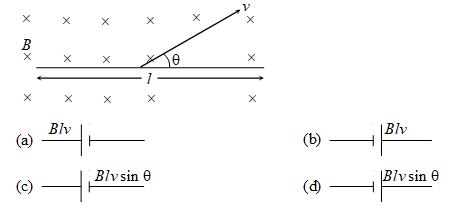
Ans. (c)
Q.8
A conducting rod PQ of length L = 1.0 m is moving with a uniform speed v = 2.0m/s in a uniform magnetic field B = 4.0 T direction into the paper. A capacitor of capacity C = 10 mF is connected as shown in figure. Then
(a) {{q}_{A}}=+80\mu C and {{q}_{B}}=-80\mu C
(b) {{q}_{A}}=-80\mu C and {{q}_{B}}=+80\mu C
(c) {{q}_{A}}=0={{q}_{B}}
(d) charge stored in the capacitor increases exponentially with time
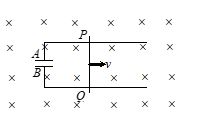
Ans. (a)
Q.9
A rod of length l, negligible resistance and mass m slides on two horizontal frictionless rails of negligible resistance by hanging a block of mass m1 by the help of insulating massless string passing through fixed massless pulley (as shown). If a constant magnetic field B acts upwards perpendicular to the plane of the figure, the terminal velocity of hanging mass is
(a) \frac{{{{m}_{1}}gR}}{{{{B}^{2}}{{l}^{2}}}} upward
(b) \frac{{{{m}_{1}}gR}}{{{{B}^{2}}{{l}^{2}}}} downward
(c) \frac{{{{m}_{1}}gR}}{{2{{B}^{2}}{{l}^{2}}}}downward
(d) \frac{{{{m}_{1}}gR}}{{{{B}^{2}}l}} downward
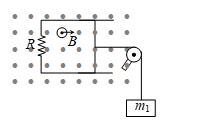
Ans. (b)
Q.10
A conducting rod AB moves parallel to x-axis in the x–y plane. A uniform magnetic field B pointing normally out of the plane exists throughout the region. A force F acts perpendicular to the rod, so that the rod moves with uniform velocity v. The force F is given by (neglect resistance of all the wires)
(a) \frac{{v{{B}^{2}}{{l}^{2}}}}{R}{{e}^{{-t/RC}}}
(b) \frac{{v{{B}^{2}}{{l}^{2}}}}{R}
(c) \frac{{v{{B}^{2}}{{l}^{2}}}}{R}\left( {1-{{e}^{{-t/RC}}}} \right)
(d) \frac{{v{{B}^{2}}{{l}^{2}}}}{R}\left( {1-{{e}^{{-2t/RC}}}} \right)

Ans. (a)
Q.11
A metal rod 1.5 m long rotates about its one end in a vertical plane at right angles to the magnetic meridian. When the frequency of rotation is 20 rev/s. (H = 0.32G), the emf induced between the ends of the rod is 4.5 mV. If instead of rod, it had been conducting disc of radius 1.5 m, then potential difference between the center of the disc and a point on the rim will be
(a) 9 mV (b) 2.25 mV (c) 45 mV (d) None of these
Ans (d)
Q.12
A conducting rod ab shown in figure moves on two frictionless parallel rails in a uniform magnetic field B. If rod is given an initial velocity (v0) at t = 0. Plot the graph between velocity of rod (v) with time (t)
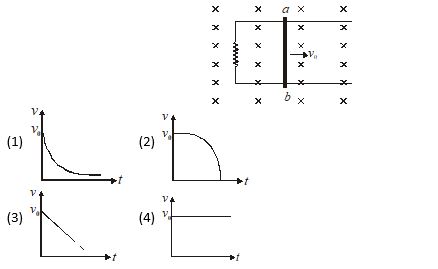
Ans. (a)
Q.13
A semicircular loop of radius r is located on the boundary of a uniform magnetic field B. The loop is set into rotation with a constant angular acceleration about an axis coinciding with a line of vector \overrightarrow{{B\,}} on the boundary. Then emf induced (e) in the loop related with time (t) as
(a) e\propto {{t}^{0}}
(b) e\propto t
(c) e\propto {{t}^{2}}
(d) e\propto \frac{1}{t}
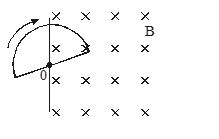
Ans. (b)
Q14
A conductor PQ, with \overrightarrow{{PQ}}=\overrightarrow{{r\,}}, moves with a velocity \overrightarrow{{v\,}} in a uniform magnetic field of induction \overrightarrow{{B\,}}. The emf induced in the rod is
(a) (\overrightarrow{{v\,}}\times \overrightarrow{{B\,}}).\,\overrightarrow{{r\,}}
(b) \overrightarrow{{v\,}}(\overrightarrow{{r\,}}\times \overrightarrow{{B\,}})
(c) \overrightarrow{{B\,.}}(\overrightarrow{{r\,}}\times \overrightarrow{{v\,}})
(d) |\overrightarrow{{r\,}}\times (\overrightarrow{{v\,}}\times \overrightarrow{{B\,}})|
Ans. (a)
